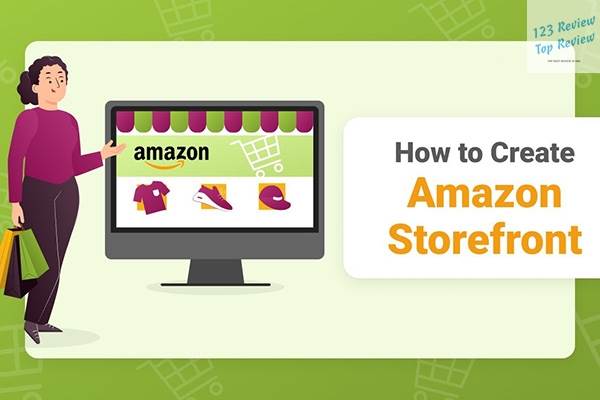Whether you’re venturing into e-commerce for the first time or expanding your existing business, Amazon provides a powerful platform to grow your brand and drive sales.
In this article, 123 Review will walk you through each step of creating an Amazon store, from setting up your seller account to analyzing performance metrics, ensuring that your store is optimized for success.
Setting Up Your Amazon Seller Account
Creating a solid foundation for your Amazon store begins with setting up your Amazon seller account. This process involves making crucial decisions, gathering necessary documentation, and ensuring your profile reflects your brand’s professionalism.

Choosing the Right Seller Plan
Amazon offers two primary selling plans: the Individual plan and the Professional plan. Understanding the differences between these plans is essential to making an informed decision.
- Individual Plan: This plan is designed for sellers who anticipate selling fewer than 40 items per month. It’s ideal for those just starting out or for sellers who want to test the waters before committing to a larger operation. The Individual plan charges a per-item fee, which can be cost-effective for low-volume sellers.
- Professional Plan: If you plan to sell more than 40 items per month or want to access advanced selling features, the Professional plan is the better choice. This plan charges a monthly subscription fee but offers benefits like access to Amazon’s advertising tools, bulk listing capabilities, and eligibility for top placement on product detail pages.
Choosing the right plan depends on your business goals, anticipated sales volume, and the level of control you want over your selling experience.
Required Documentation for Registration
Before you can start selling on Amazon, you’ll need to provide specific documentation to verify your identity and business legitimacy. Having these documents ready will streamline the registration process and prevent delays.
- Personal Identification: You’ll need to provide a government-issued ID, such as a passport or driver’s license.
- Tax Information: Amazon requires your tax identification number (TIN) or Social Security number (SSN) for tax reporting purposes. If you’re registering as a business, you’ll need to provide your Employer Identification Number (EIN).
- Bank Account Information: To receive payments from Amazon, you must link a valid bank account to your seller account. Ensure that the account can receive ACH payments and is in the name of the registered seller.
Completing these steps accurately is crucial for a smooth registration process and will enable you to start selling without unnecessary interruptions.
Completing Your Profile Information
Once your seller account is active, it’s time to set up your profile. Your Amazon seller profile is your brand’s face on the platform, so it’s essential to present a professional image.
- Business Name: Choose a business name that aligns with your brand and resonates with your target audience. This name will be displayed on your storefront and in customer communications.
- Logo and Branding: Upload a high-quality logo that represents your brand. Consistent branding across your Amazon store, product listings, and other marketing materials helps build recognition and trust.
- Contact Information: Provide accurate and up-to-date contact information. This includes your business address, phone number, and email address. Transparent communication is key to building customer trust.
A complete and well-maintained profile not only builds credibility but also helps differentiate your store from competitors, setting the stage for long-term success.
Listing Products on Your Amazon Store
Your product listings are the core of your Amazon store. They are the primary way customers will discover and learn about your products. To maximize your sales potential, it’s essential to list your products strategically and effectively.
Identifying Profitable Product Niches
Choosing the right products to sell on Amazon is crucial to your success. This process begins with identifying profitable niches that have strong demand but are not oversaturated with competition.
- Market Research: Start by conducting thorough market research using tools like Jungle Scout, Helium 10, or AMZScout. These tools provide insights into product trends, sales volumes, and competition levels. Look for products with consistent demand, high search volume, and moderate competition.
- Customer Pain Points: Consider what problems your products can solve for customers. Products that address specific pain points tend to perform well because they meet a clear need in the market.
- Supplier Relationships: Establish relationships with reliable suppliers who can provide high-quality products at competitive prices. Consistent supply and product quality are critical factors in maintaining customer satisfaction and securing repeat business.
By focusing on profitable niches and reliable suppliers, you can build a product portfolio that is not only competitive but also aligned with market demands.
Writing Effective Product Descriptions
Once you’ve identified your products, the next step is to create compelling product descriptions. A well-crafted product description not only informs but also persuades potential customers to make a purchase.
- Highlight Features and Benefits: Your product description should clearly outline the key features and benefits of your product. Use bullet points to make the information easy to scan. Focus on what makes your product unique and why it’s the best choice for your target audience.
- Keyword Integration: Incorporate relevant keywords into your product descriptions to improve visibility in Amazon’s search results. However, ensure that the keywords fit naturally within the text to maintain readability.
- Storytelling: Engage your customers by telling a story about how your product can enhance their lives. Whether it’s the convenience of a kitchen gadget or the durability of outdoor gear, storytelling can create an emotional connection with your audience.
A persuasive product description, combined with strategic keyword usage, can significantly boost your conversion rates and help your listings stand out.
Using High-Quality Product Images
High-quality product images are essential for showcasing your products in the best possible light. Images are often the first thing customers notice, so they need to be visually appealing and informative.
- Professional Photography: Invest in professional photography to ensure your product images are clear, well-lit, and high resolution. This is particularly important for products where color, texture, or details play a significant role in the buying decision.
- Multiple Angles: Provide images from multiple angles to give customers a comprehensive view of the product. Include close-ups of important features, such as buttons, stitching, or packaging, to highlight the quality and craftsmanship.
- Lifestyle Images: In addition to standard product images, include lifestyle images that show the product in use. These images help customers visualize how the product fits into their lives, increasing their likelihood of making a purchase.
Using high-quality images not only enhances the appeal of your product listings but also helps build trust with potential customers, leading to higher conversion rates.
Optimizing Your Amazon Store for SEO
Search engine optimization (SEO) is critical for driving traffic to your Amazon store. By optimizing your product listings for Amazon’s search algorithm, you can increase your visibility and attract more customers.
Conducting Keyword Research
Keyword research is the foundation of Amazon SEO. Identifying the right keywords can significantly improve your product’s visibility in search results.
- Research Tools: Utilize tools like Google Keyword Planner, Amazon’s search bar suggestions, and third-party platforms like MerchantWords to identify relevant keywords for your products. Focus on keywords with high search volume and low competition.
- Long-Tail Keywords: Consider using long-tail keywords, which are more specific phrases that customers might use when searching for a product. While they may have lower search volumes, they often result in higher conversion rates because they reflect a more targeted customer intent.
- Competitor Analysis: Analyze the keywords used by your competitors in their product listings. This can provide insights into what’s working in your niche and help you refine your keyword strategy.
Thorough keyword research ensures that your product listings are optimized for the terms that customers are actively searching for, increasing your chances of being discovered.
Implementing Keywords in Your Listings
Once you have identified your target keywords, it’s important to implement them effectively throughout your product listings.
- Product Titles: The product title is one of the most important elements for Amazon SEO. Include your primary keyword in the title, along with secondary keywords if space allows. Make sure the title is clear, concise, and accurately reflects the product.
- Bullet Points: Incorporate keywords into the bullet points that highlight the key features and benefits of the product. Each bullet point should be informative and add value, helping customers understand why they should choose your product.
- Product Description: Use the product description to naturally integrate additional keywords. Avoid keyword stuffing, as this can make the description difficult to read and may result in penalties from Amazon’s algorithm.
Proper keyword implementation ensures that your listings are both optimized for search engines and user-friendly, striking the right balance between visibility and readability.
Utilizing Amazon’s A+ Content Feature
Amazon’s A+ Content feature is available to Professional sellers enrolled in the Amazon Brand Registry. This feature allows you to enhance your product listings with rich media content, providing a more engaging shopping experience.
- Enhanced Product Descriptions: A+ Content allows you to create more detailed product descriptions with additional images, videos, and comparison charts. This helps customers make informed buying decisions and can lead to higher conversion rates.
- Brand Storytelling: Use A+ Content to tell your brand’s story. Share your brand’s history, values, and mission, helping to build a connection with customers and differentiate your products from competitors.
- SEO Benefits: While A+ Content itself doesn’t directly impact Amazon’s search rankings, it can improve your product’s conversion rates, which is a factor in Amazon’s algorithm. Higher conversion rates can lead to better visibility in search results.
Utilizing A+ Content not only enhances the presentation of your products but also strengthens your brand presence on Amazon, leading to increased customer loyalty and sales.
Marketing Your Amazon Store
Creating a successful Amazon store requires more than just listing products; you need to actively promote your store to drive traffic and sales. A well-rounded marketing strategy includes both on-platform and off-platform tactics.
Leveraging Amazon Advertising
Amazon Advertising provides powerful tools to promote your products directly on the platform. By leveraging these tools, you can increase your product’s visibility and drive more sales.
- Sponsored Products: Sponsored Products are ads that appear in search results and on product detail pages. These ads are keyword-targeted, making them an effective way to reach customers who are actively searching for products like yours.
- Sponsored Brands: Sponsored Brands ads showcase your brand logo, a custom headline, and multiple products. These ads appear at the top of search results, helping to build brand awareness and drive traffic to your store.
- Sponsored Display: Sponsored Display ads allow you to reach customers both on and off Amazon. These ads can be used to retarget customers who have viewed your products but haven’t yet made a purchase.
Amazon Advertising is a powerful tool for driving traffic and increasing sales, especially when used strategically with targeted keywords and well-designed ad creatives.
Building Your Brand Presence on Social Media
Social media is an essential component of any modern marketing strategy. By building a strong brand presence on platforms like Facebook, Instagram, and Twitter, you can drive traffic to your Amazon store and engage with your target audience.
- Content Marketing: Create engaging content that resonates with your target audience. Share product updates, behind-the-scenes looks, customer testimonials, and industry news. Consistent posting helps keep your brand top-of-mind for potential customers.
- Influencer Partnerships: Collaborate with influencers who align with your brand. Influencers can help amplify your reach and introduce your products to a larger audience. Choose influencers whose followers are likely to be interested in your products.
- Social Media Advertising: Use social media advertising to target specific demographics and drive traffic to your Amazon store. Platforms like Facebook and Instagram offer detailed targeting options, allowing you to reach potential customers based on their interests, behaviors, and location.
A strong social media presence not only drives traffic to your Amazon store but also helps build a community around your brand, fostering long-term customer loyalty.
Engaging with Amazon Reviews and Feedback
Customer reviews and feedback are crucial for building trust and credibility on Amazon. Actively managing and responding to reviews can help you maintain a positive reputation and improve your product listings.
- Encouraging Positive Reviews: After a customer makes a purchase, encourage them to leave a review. You can do this through follow-up emails, product inserts, or Amazon’s “Request a Review” button. Positive reviews can significantly impact your product’s visibility and conversion rates.
- Responding to Negative Feedback: Negative reviews are inevitable, but how you handle them can make a big difference. Respond to negative feedback promptly and professionally, addressing the customer’s concerns and offering solutions. This shows potential customers that you care about their satisfaction.
- Monitoring Review Trends: Regularly monitor your reviews to identify common themes or issues. Use this feedback to make improvements to your products or customer service, ensuring that you’re continuously meeting customer expectations.
Actively engaging with reviews not only helps improve your product listings but also demonstrates your commitment to customer satisfaction, which can lead to increased sales and repeat business.
Analyzing and Improving Your Amazon Store Performance
Once your Amazon store is up and running, it’s important to continuously monitor and analyze your performance. By understanding key metrics and making data-driven decisions, you can optimize your store for ongoing success.
Key Performance Metrics to Monitor
Monitoring the right metrics is essential for assessing the health of your Amazon store and identifying areas for improvement.
- Sales Performance: Track your total sales, units sold, and revenue over time. Look for trends and patterns that can inform your marketing strategies and inventory management.
- Conversion Rate: Your conversion rate is the percentage of visitors who make a purchase. A low conversion rate may indicate issues with your product listings, pricing, or customer experience.
- Customer Metrics: Monitor customer metrics such as return rates, average order value, and customer satisfaction scores. These metrics can provide insights into how well your products are meeting customer needs.
Regularly reviewing these metrics allows you to make informed decisions about your marketing, pricing, and inventory strategies, ensuring that your Amazon store remains competitive.
Utilizing Amazon’s Analytics Tools
Amazon provides a range of analytics tools that can help you track your store’s performance and make data-driven decisions.
- Amazon Seller Central: Seller Central offers a wealth of data on your sales, orders, and customer feedback. Use this platform to track key performance metrics, manage inventory, and monitor your advertising campaigns.
- Amazon Brand Analytics: If you’re enrolled in Amazon Brand Registry, you can access Amazon Brand Analytics. This tool provides insights into customer behavior, including search term reports, market basket analysis, and item comparison data.
- A/B Testing: Conduct A/B testing on your product listings to determine what changes can improve performance. Test different product titles, images, descriptions, and pricing to see what resonates best with your audience.
Leveraging Amazon’s analytics tools allows you to make informed decisions based on real data, helping you continuously improve your store’s performance.
Scaling Your Amazon Business
As your Amazon store grows, you may want to explore opportunities to scale your business and increase your revenue.
- Expanding Your Product Line: Consider adding new products to your store that complement your existing offerings. Conduct market research to identify potential niches and ensure there’s demand for the products you plan to add.
- Exploring International Markets: If you’re successful in your home market, consider expanding to international marketplaces. Amazon Global Selling allows you to reach customers in other countries, opening up new revenue streams.
- Automating Processes: As your business grows, automation can help you manage your operations more efficiently. Explore tools and software that can automate tasks such as order fulfillment, inventory management, and customer service.
Scaling your Amazon business requires careful planning and execution, but with the right strategies in place, you can achieve significant growth and long-term success.
Conclusion
Creating an Amazon store is a powerful way to reach a global audience and build a successful e-commerce business. By following the steps outlined in this guide—from setting up your seller account to optimizing your product listings and marketing your store—you can maximize your chances of success on Amazon. Remember to continuously monitor your store’s performance, engage with your customers, and explore opportunities for growth. With dedication and the right strategies, your Amazon store can become a thriving business that delivers consistent revenue and growth.





